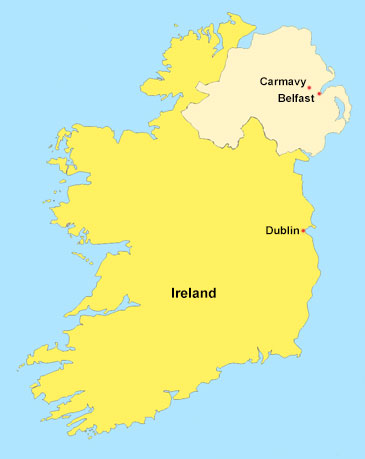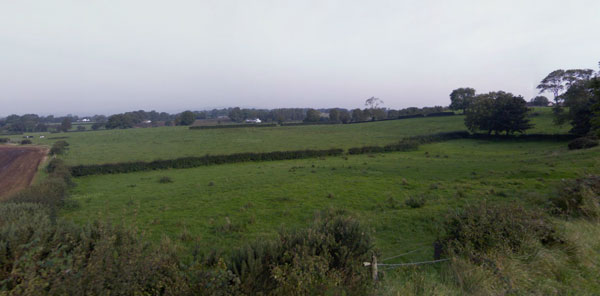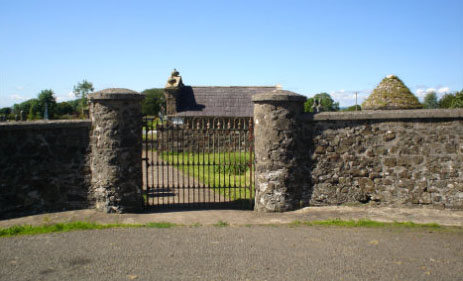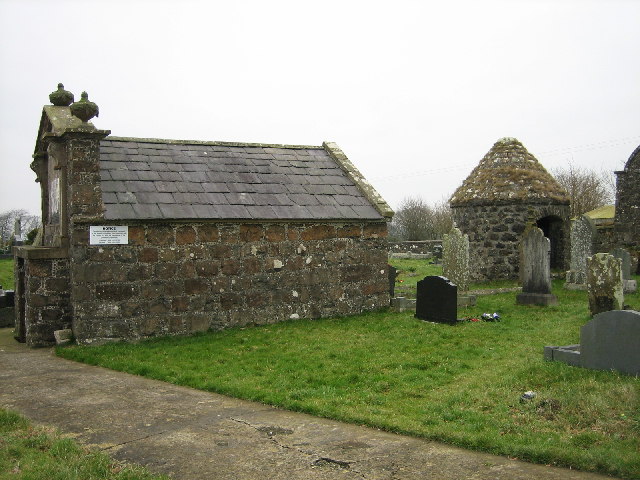 Chris Korte's New Zealand Genealogy Project
Chris Korte's New Zealand Genealogy Project
Carmavy, Northern Ireland
About page
This page provides some information about Carmavy in Northern Ireland. Carmavy was were Thomas McLernon, my great grandfather, was born and grew up before migrating to New Zealand in 1886. His father James McLernon farmed at Carmavy, and is buried in the Carmavy Cemetery. Thomas McLernon, or Thomas McLaren as he was known in New Zealand, named his farm, at Manawaru in the Waikato, Carmavy after his birthplace.
If you can provide additional information, or corrections, please contact (see Info menu).
Carmavy (Carmavey)
Carmavy is situated in in the parish of Killead, County Antrim, Northern Ireland. It is in the townland of Grange of Carmavy. The accepted, modern spelling is Carmavey.
Carmavy is not have an established settlement, but rather farmland with scattered houses and farms. There is no church in Carmavy, but there is a graveyard. The Grange of Carmavy, as mapped in the Ordinance Survey of 1832-33, was an area approximately 3 km by 2 km with the cemetery near the center.
As can be seen from the map, Carmavy is located close to Belfast (18 km). It is south of Antrim (10 km) and near the Belfast International Airport (7 km).

The farmland at Carmavey is a mixture of cropland and pasture. There are a number of dairy farms and cereal crops are grown. A cattle stud farm is located near the Graveyard - Carmavy Simmentals.

Farmland at Carmavey
Google Streetview2008 photo.
1851 Census
Although few 1851 census records have survived from Ireland, there are fragments for Killead, County Antrim, including for the Grange of Carmavy Townland - 42 households and 201 people.
The main occupations were in agriculture (27 farmers, 7 agricultural labourers and 3 ploughmen) and textiles (24 flowerers, 10 muslin sewers, 6 linen weavers, 3 spinners). Flowerers were women who embroidered flowers or similar designs on muslin.
Other occupations included: 6 labourers, 3 servants, 2 shoemakers, 2 coopers, 2 publicans, a tailor, a blacksmith, a carpenter, a thatcher and a schoolmaster (Samuel McComb). One of the publicans also was a grocer. Only two households had live-in servants, one of them being the residence of Archibald McComb where 2 kitchen servants were employed.
Archibald McComb was the grandfather of Thomas McLernon who migrated to New Zealand. Samuel McComb, the schoolmaster at Carmavy in 1851, was the son of Archibald McComb.
The McLernon family were not recorded amongst the 1851 census records for the Grange of Carmavy Townland.
1901 Census
In the 1901 Census there were 28 families and households in the Grange of Carmavy Townland and 124 people. The population had almost halved from 1851.
Agriculture was the main industry by 1901, with textile work not being mentioned as an occupation. The main occupations recorded in the 1901 census were: farmer (40 including farmer's sons and daughters), farm servants (11), servants (3), labourer (2), publicans (2), carpenters (2), inn keeper (1).
There were 6 Catholics, 42 Presbyterians in the Grange of Carmavy Townland.
Graveyard
Carmavy Graveyard is a walled enclosure on Carmavy Road, measuring 57 x 54 yards (52 x 49 meters). The burial ground is managed by a committee and tended by a sexton who lives in the house adjacent to the graveyard.
Carmavy graveyard is apparently very ancient, with headstones having been recorded from 1698. The graveyard was once the site of a catholic chapel. The chapel was destroyed in the 1600's by the English and Scottish, with the catholic parishioners inside. Joe Graham provides more detail of this incident. Most of the graves are those of the Scottish settlers and their descendants.

Gates to Carmavy Graveyard before Carmavy Road was widened in 2008 and a new wall erected.

Carmavy Graveyard
Page last updated on 22 July 2018.







